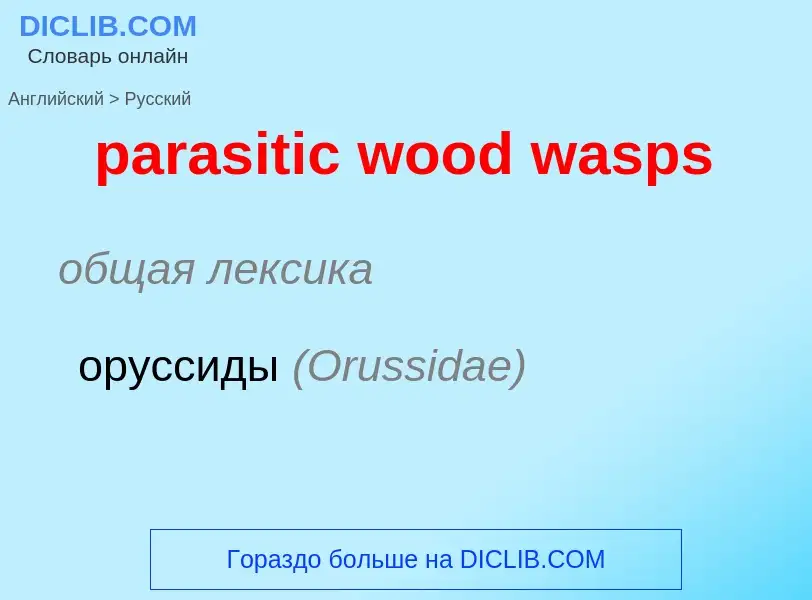Traduzione e analisi delle parole tramite l'intelligenza artificiale ChatGPT
In questa pagina puoi ottenere un'analisi dettagliata di una parola o frase, prodotta utilizzando la migliore tecnologia di intelligenza artificiale fino ad oggi:
- come viene usata la parola
- frequenza di utilizzo
- è usato più spesso nel discorso orale o scritto
- opzioni di traduzione delle parole
- esempi di utilizzo (varie frasi con traduzione)
- etimologia
parasitic wood wasps - traduzione in russo
общая лексика
оруссиды (Orussidae)
общая лексика
паразитарное заболевание
паразитоз
общая лексика
паразитарное заболевание
паразитоз
медицина
паразитоносительство
Definizione
Wikipedia
 (7686081848).jpg?width=120)
Parasitoid wasps are a large group of hymenopteran superfamilies, with all but the wood wasps (Orussoidea) being in the wasp-waisted Apocrita. As parasitoids, they lay their eggs on or in the bodies of other arthropods, sooner or later causing the death of these hosts. Different species specialise in hosts from different insect orders, most often Lepidoptera, though some select beetles, flies, or bugs; the spider wasps (Pompilidae) exclusively attack spiders. More rarely, parasitoid wasps may use plant seeds as hosts, such as Torymus druparum.
Parasitoid wasp species differ in which host life-stage they attack: eggs, larvae, pupae, or adults. They mainly follow one of two major strategies within parasitism: either they are endoparasitic, developing inside the host, and koinobiont, allowing the host to continue to feed, develop, and moult; or they are ectoparasitic, developing outside the host, and idiobiont, paralysing the host immediately. Some endoparasitic wasps of the superfamily Ichneumonoidea have a mutualistic relationship with polydnaviruses, the viruses suppressing the host's immune defenses.
Parasitoidism evolved only once in the Hymenoptera, during the Permian, leading to a single clade, but the parasitic lifestyle has secondarily been lost several times including among the ants, bees, and yellowjacket wasps. As a result, the order Hymenoptera contains many families of parasitoids, intermixed with non-parasitoid groups. The parasitoid wasps include some very large groups, some estimates giving the Chalcidoidea as many as 500,000 species, the Ichneumonidae 100,000 species, and the Braconidae up to 50,000 species. Host insects have evolved a range of defences against parasitoid wasps, including hiding, wriggling, and camouflage markings.
Many parasitoid wasps are considered beneficial to humans because they naturally control agricultural pests. Some are applied commercially in biological pest control, starting in the 1920s with Encarsia formosa to control whitefly in greenhouses. Historically, parasitoidism in wasps influenced the thinking of Charles Darwin.

 (7686081848).jpg?width=200)
 (cropped).jpg?width=200)



.jpg?width=200)




![aphelinid]] wasp, bred commercially to control [[whitefly]] in [[greenhouse]]s aphelinid]] wasp, bred commercially to control [[whitefly]] in [[greenhouse]]s](https://commons.wikimedia.org/wiki/Special:FilePath/Encarsia formosa, an endoparasitic wasp, is used for whitefly control.jpg?width=200)


![[[Housefly]] pupae killed by parasitoid wasp larvae (probably [[Pteromalidae]]). Each pupa has one hole through which a single adult wasp has emerged after feeding on the housefly larva. [[Housefly]] pupae killed by parasitoid wasp larvae (probably [[Pteromalidae]]). Each pupa has one hole through which a single adult wasp has emerged after feeding on the housefly larva.](https://commons.wikimedia.org/wiki/Special:FilePath/Housefly pupae killed by wasp larvae.jpg?width=200)
 female (cropped).jpg?width=200)


![Parasitoid wasp ([[Ichneumonidae]]) pointing ovipositor at [[cinnabar moth]] larva, just after ovipositing. The larva wriggles vigorously to try to avoid the attack. Parasitoid wasp ([[Ichneumonidae]]) pointing ovipositor at [[cinnabar moth]] larva, just after ovipositing. The larva wriggles vigorously to try to avoid the attack.](https://commons.wikimedia.org/wiki/Special:FilePath/Parasitoid wasp pointing ovipositor at cinnabar moth larva.jpg?width=200)
.jpg?width=200)
 (9687661511).jpg?width=200)
.jpg?width=200)
![''[[Trissolcus]]'' (family Platygastridae) on ''[[Chinavia]]'' eggs ''[[Trissolcus]]'' (family Platygastridae) on ''[[Chinavia]]'' eggs](https://commons.wikimedia.org/wiki/Special:FilePath/Trissolcus on Chinavia eggs.jpg?width=200)
 (25808496580) (cropped).jpg?width=200)


